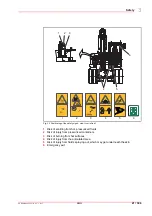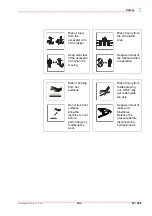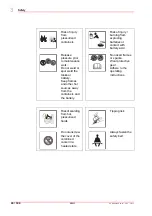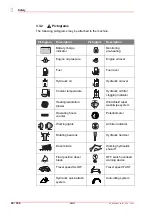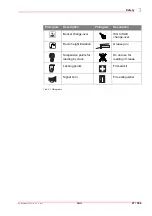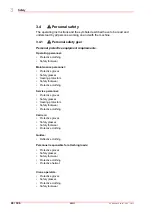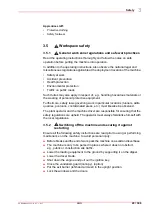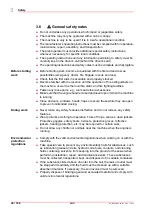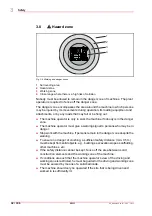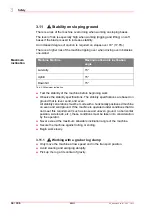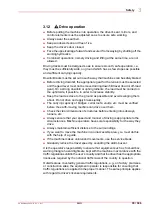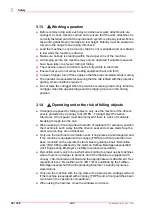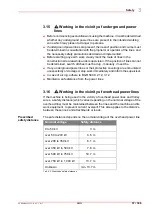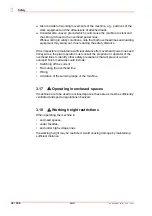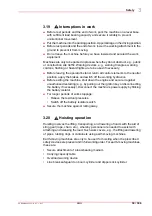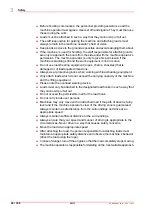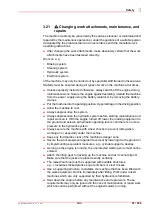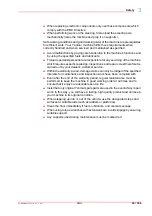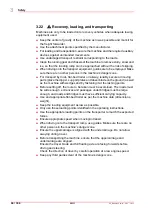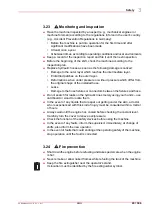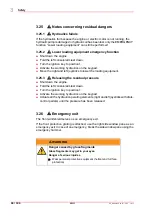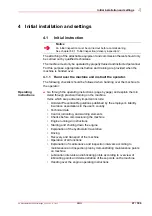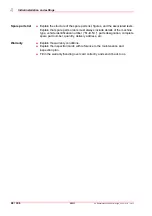
B95W
Safety
03_Sicherheit_en.fm - V 0.1 - 1.8.17
35 / 306
3
46
3.12
Drive operation
Before putting the machine into operation, the driver's seat, mirrors, and
control elements must be adjusted so as to ensure safe working.
Always wear the seat belt.
Keep windows clean and free of ice.
Keep the driver's door closed.
Face the uppercarriage forward and secure it from swaying by shutting off the
working hydraulics.
Combined operations, namely driving and lifting at the same time, are not
allowed.
Driving tracks must be designed so as to ensure smooth, safe operation, i.e.,
they must be sufficiently wide, on ground which has as few slopes as possible
and sufficient carrying capacity.
Downhill tracks must be set out in such a way that machines can be safely braked.
Before driving downhill, the appropriate gear for the terrain must be selected
and the gear lever must not be moved during downhill travel (road or off-road
gear). On a strong downhill or uphill gradients, the load must be carried on
the uphill side, if possible, in order to increase stability.
Keep the load as close to the ground as possible and avoid swinging them
about. Do not drive and apply brakes jerkily.
The carrying capacity of bridges, cellar roofs, vaults, etc. must be verified
before the earth-moving machine can drive over them.
Check the clear dimensions of structures before entering into subways,
tunnels, etc.
Always ensure that your speed and manner of driving is appropriate to the
circumstances. Machine operators have sole responsibility for the way they
drive.
Always maintain sufficient distance to the surroundings.
If you want to move the machine in an inaccessible area, you must do this
with the help of a guide.
If the machine makes unintended movements, use the service break.
Gradually reduce the travel speed by sounding the alarm buzzer.
It is the operator's responsibility to ensure that equipment such a s first-aid box,
warning triangle, hazard lights are kept with the machine in accordance with the
traffic regulations valid in the user’s country and that the driver has the appropriate
license as required by the national traffic laws of the country in question.
Outside areas covered by general traffic regulations, e.g., on factory premises
or construction sites, the equipment operator is responsible for ensuring that
traffic regulations are applied in the proper manner. The same principle applies
with regard to driver's license requirements.
Summary of Contents for B95W
Page 2: ......
Page 8: ...B95W Table of contents 6 306 1 01_Inhaltsverzeichnis_enIVZ fm V1 0 1 8 17 10 ...
Page 52: ...B95W Description 50 306 5 05_Beschreibung_en fm V1 0 1 8 17 11 ...
Page 58: ...B95W Description 56 306 5 05_Beschreibung_en fm V1 0 1 8 17 11 ...
Page 206: ...B95W Maintenance 204 306 6 06_Wartung und Pflege_en fm V1 0 1 8 17 20 ...
Page 208: ...B95W Operation 206 306 7 07_Bedienung_en fm V1 0 1 8 17 26 ...
Page 272: ...B95W Transport 270 306 8 08_Transport_en fm V1 0 1 8 17 27 ...
Page 302: ...B95W Troubleshooting 300 306 10 10_Fehlerbeseitigung_en fm V1 0 1 8 17 30 ...
Page 309: ......

